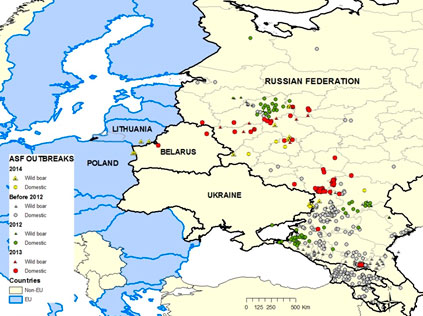The presence of ASF was confirmed in the EU
Lina Mur Gil & José Manuel Sánchez-Vizcaíno
February 24th, 2014. SUAT-UCM
In recent weeks it has been reported for the first time, the presence of African swine fever (ASF) on two EU countries: Lithuania and Poland that were never affected by this disease. Since the entrance of ASF in Eastern Europe in mid-2007, the disease has followed a continuous and steady spread, greatly expanding its diffusion zones. These events posed a potential risk to the swine industry in the European Union (EU), as has seen confirmed in the last month.
 Outbreaks reported to OIE between 2007 and 19 February 2014 in Eastern Europe
Outbreaks reported to OIE between 2007 and 19 February 2014 in Eastern Europe
Source: Own elaboration with data from OIE, 2014
During the early years, ASF remained more or less confined in the Caucasus region, affecting Georgia, Armenia, Azerbaijan and southern Russia. However, since summer 2011, the ASF outbreaks became common in the central region of Russia, where the disease is present in endemic form, affecting both domestic and wild boar (Sánchez-Vizcaíno et al., 2013). After settling in this central area, ASF continued to spread westward, and the first outbreaks were reported in 2012 in Ukraine, and in 2013 in Belarus. One of the reported outbreaks in Belarus was located within 30 km of the border with Lithuania.
These outbreaks caused alarm in the EU, fearing a possible entry of the disease in the EU, as it has ended up happening. The January 24, 2014 the presence of two death wild boar in Lithuania, positive to ASFV was notified to the OIE (OIE, 2014a). These wild boar were found within 15 km of the border with Belarus. The laboratory analysis confirmed the presence of ASFV in the wild boar by PCR technique. The virus was also. Antibodies were also found in tissue exudates. Another positive wild boar was also found dead in Poland in February 17, located only 900m from the border with Belarus (OIE, 2014b).
These are the first two EU countries affected by ASF from outbreaks in Eastern Europe. In both cases, the entry of the disease came from wild animals, which highlights the role that these animals may have in spreading the virus under favorable conditions. The fact that the infection has reached the gates of the EU through wildlife not only confirms the absence of effective control measures in the affected areas, but also the potential presence of the virus in much broader regions than the officially notified.
Sources:
- Sánchez-Vizcaíno JM, Mur L, Martínez-López B. African swine fever (ASF): Five years around Europe. Vet Microbiol. 26; 165 (1-2):45-50.
- World Organization for Animal Health, 2014a: WAHID database. Informe de notificación inmediata, OIE Ref: 14690.
- World Organization for Animal Health, 2014b: WAHID database. Informe de notificación inmediata, OIE Ref: 14793.


